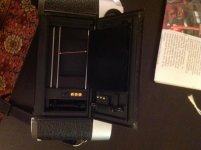mszargar
Established
Hello forummates,
I have just bought a M6 classic, and have checked it all over according to the micro-bible of M buyers. All seems perfect. The camera has been used, I am sure of that, but the last three owners have apparently taken great care of it. You can't find signs of use on it without thoroughly searching...
The only thing I could not test when I bought the camera, obviously, was the focus. Now, I have a ground glass from a combo viewfinder (Zenit) and a 15x loupe. So, first things first, when I got home, I put the M6 on a tripod, focused on a lamp shade, put the camera on B, put the unpolished side of the ground glass on the film rail and the loupe on the backside (polished side) of the ground glass, to see whether the camera focuses accurately.
But it seems there is a difference between what the rangefinder sees as focused on what the lens sees as focused. This is a Voigtlander Nokton Classic 35 1.4 and I am focusing it on a shade 2-3 meters away. I have tried some Jupiter lenses I have for my Zorki, and they shows the same focus error, I supposed the mis-focus would be different as my Jupiters are not collimated for M yet. I tested the Jupiters on my Zorki, and there too, I get this difference. I have shot some rolls of film with the Zorki before, and sometimes used it for critical focusing, but I could never make sure whether the focus was accurate or there was a little bit of back focusing because the RF patch wasn't contrasty enough for me to trust my own focus.
I just wonder if I am doing the test the wrong way. I can send the camera for a CLA (it has been CLAd about 3 years ago in Germaby), but I want to make sure there are grounds for doing that. Also, it is important for me to collimate the Jupiter lenses I have (cheap, classic look), and for that, I need to master the art of rangefinder testing.
Please let me know if you have suggestions about my testing process. Please note that taking test shots is not really an option for now, because it does not allow for real-time lens adjustment.
I have just bought a M6 classic, and have checked it all over according to the micro-bible of M buyers. All seems perfect. The camera has been used, I am sure of that, but the last three owners have apparently taken great care of it. You can't find signs of use on it without thoroughly searching...
The only thing I could not test when I bought the camera, obviously, was the focus. Now, I have a ground glass from a combo viewfinder (Zenit) and a 15x loupe. So, first things first, when I got home, I put the M6 on a tripod, focused on a lamp shade, put the camera on B, put the unpolished side of the ground glass on the film rail and the loupe on the backside (polished side) of the ground glass, to see whether the camera focuses accurately.
But it seems there is a difference between what the rangefinder sees as focused on what the lens sees as focused. This is a Voigtlander Nokton Classic 35 1.4 and I am focusing it on a shade 2-3 meters away. I have tried some Jupiter lenses I have for my Zorki, and they shows the same focus error, I supposed the mis-focus would be different as my Jupiters are not collimated for M yet. I tested the Jupiters on my Zorki, and there too, I get this difference. I have shot some rolls of film with the Zorki before, and sometimes used it for critical focusing, but I could never make sure whether the focus was accurate or there was a little bit of back focusing because the RF patch wasn't contrasty enough for me to trust my own focus.
I just wonder if I am doing the test the wrong way. I can send the camera for a CLA (it has been CLAd about 3 years ago in Germaby), but I want to make sure there are grounds for doing that. Also, it is important for me to collimate the Jupiter lenses I have (cheap, classic look), and for that, I need to master the art of rangefinder testing.
Please let me know if you have suggestions about my testing process. Please note that taking test shots is not really an option for now, because it does not allow for real-time lens adjustment.




